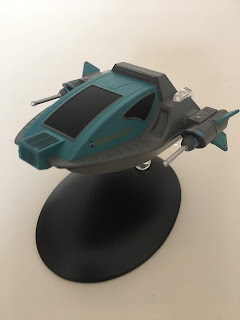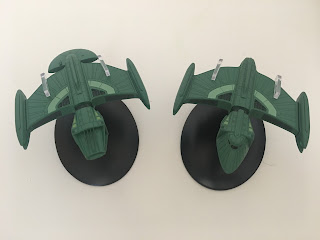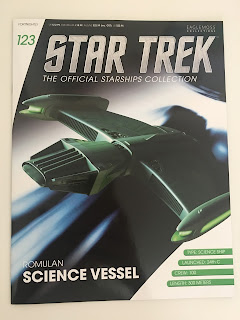It is both a joy and with sadness that I write this piece because while the USS Discovery has finally arrived, news is also out there that the Discovery Starships Collection has been suspended until later in the year (nb probably June...!)
But hey, at least we have the Shenzhou and the Discovery herself to drool over while we wait for any further releases so every cloud an' all that...
Really?! Yes, absolutely. I mean I was blown away by the quality of the Shenzhou with Issue One but the Discovery dials it up to warp 9.9. For one thing, this ship is bloody long. In fact having seen pictures and the ship on the TV I still didn’t appreciate just how long she was until the box arrived and I popped her out of the polystyrene packaging.
Proportionately the Discovery is very different from what you might expect with a small, segmented saucer, stumpy neck section, wedge-shaped body and those striking, long, pointed warp nacelles - it’s like she’s been squashed and pulled in all sorts of new directions and of course there's the echoes back to the Planet of the Titans USS Enterprise concept that are more than evident in the craft.
 Once more the starship is a masterful combination of metal and plastic and unusually for a Starfleet ship this one is bronzed, brown and a shade of silver rather than grey or white. Definitely a different vibe on this ship to anything else that's graced any point of the collection.
Once more the starship is a masterful combination of metal and plastic and unusually for a Starfleet ship this one is bronzed, brown and a shade of silver rather than grey or white. Definitely a different vibe on this ship to anything else that's graced any point of the collection.
The split concentric circles of the primary hull are themselves plastic moulded with a beautifully subtle and underplayed aztec paint scheme on both inner and outer rings. There's noticeably no panel scoring and the inside edges of both rings are painted up in a dark brown which turns up to highlight sections of the Discovery. On both these edges Eaglemoss have managed to etch in rows of tiny windows but have not avoided the usual misalignment to the recesses. Tiny detail to make out but they're not in the right places. Oh, one thing - they don't spin so you won't have to worry about your model suddenly disappearing into the Mirror Universe anytime soon.
 The windows on the underside edge of the inner circular section suffer from the same issue although there is a bit less surface greebling which is offset with a slightly higher level of panelling. The paint variations are incredibly fractional and you have to get the right light to make out the changes - that and you need a good bit of sunshine to show where the USS Discovery name is curved around the hull surface of the inner ring.
The windows on the underside edge of the inner circular section suffer from the same issue although there is a bit less surface greebling which is offset with a slightly higher level of panelling. The paint variations are incredibly fractional and you have to get the right light to make out the changes - that and you need a good bit of sunshine to show where the USS Discovery name is curved around the hull surface of the inner ring.
To the front of the primary hull and almost indistinguishable from the paintwork is the NCC-1031 registry and ship name just above it. At the centre and in metal is the distinct bridge dome successfully highlighted - in the right sections - in white.
The underside of the saucer Now one of the clever bits of construction here is that the saucer is "clipped" into the neck of the ship by a section of dark brown hull which runs back down to the Engineering Section. This whole neck piece is finished with printed-on windows but Eaglemoss have avoided recessing the window ports first which means that these aren't misaligned to anything and are flush to the surface. Definitely a good choice to just mark straight onto the hull.
The neck itself is actually two pieces with the rear plastic and the bronze front section in metal. The two pieces reach around the saucer section(s) and meet at that bridge module with the underside and the piece surrounding the bridge dome also being in the heavier material.
Drop down again and we find ourselves at the metal secondary hull. Once more there's the aztec paint scheme and what you come to realise is that whatever angle you view her from, there's always a hint of the slight pattern that covers the whole surface. It's not as obvious as the two-tone on the Enterprise-D but it's there.
The large metal delta shape of the secondary hull carries a lot of weight but look again and you'll see that the leading edges of the hull are actually plastic with sensor and window detail from the front to back. Both the upper and lower pieces are mainly bronzed with striped highlights in silver which are raised from the main surface and add much needed depth to the ship. It doesn't seem like overkill either with the colours striking a visually exciting balance.
Along the back of the secondary hull we also have the shuttlebay framed by the red glow of the impulse engines. This is actually a single translucent red strip right across the back painted up for the bay, the engines and then the brown of the bodywork at the ends. It's a clever use of the single piece of plastic to edge the hull and the metal.
Underneath there are again the simple panel lines on the delta-shaped body but there is another inset piece to the hull. It's an almost triangular section that stretches from the midpoint of the underside and encompasses the tiny deflector dish at the front. The deflector is one of the few translucent (blue) elements of the Discovery and even bears a small protruding sensor point. The choice to put it in plastic and translucent is brilliant. It works very well and again the combination of building materials is genius.
The metalwork extends under into the base of the warp engines. These are the most spectacular piece of the Discovery shape, tapering almost to a point and extending far further back than any warp engine has ever gone before. The design is gorgeous with Eaglemoss setting a blue translucent bussard collector at the front and thin warp field grilles along the sides. The detail on the surface of the engines is as minimalist as the rest of the ship with only a few panel markings and some darker brown highlights along the top and just visible at the back.
 They're very solid as well and first impression out of the box was that they would be a nightmare and bend like anything. Luckily the metal gives a lot of support and they don't taper to too thin an end.
They're very solid as well and first impression out of the box was that they would be a nightmare and bend like anything. Luckily the metal gives a lot of support and they don't taper to too thin an end.
Not only do you get the ship in the box but also the mini-scale magazine covering some of the ship's more notable details and specs plus a section detailing exactly how the design came about as well as evolving from those first early CG shots that teased us well before the show launched. John Eaves has produced a real winner and Eaglemoss have done it justice on page as well as in 3D with a host of design sketches and stories behind the difficulties in finalising the shape of the warp engines. What the magazine does contrast to the model is the colour scheme with a more distinct bronze/silver paint job on the page. One grumble is that there are no screenshots from the series to see the ship in action and the only pic we do get from the show is a promo one of Lorca in the captain's chair. Luckily all those sketches more than make up for it.
The shape and form of the Discovery is destined to become iconic and Eaglemoss have produced a replica of it that is absolutely goddamn stunning from every angle. It's one of my all-time favourites that hey have produced from regular, special and bonus issues. Love it and I'm shocked it's not already sold out - but that might be down to the £29.99 price point.
What did you think to the USS Discovery model?
What did you think to the USS Discovery model?
Follow us on Twitter
+1 us on Google+
Add us on Tumblr





































